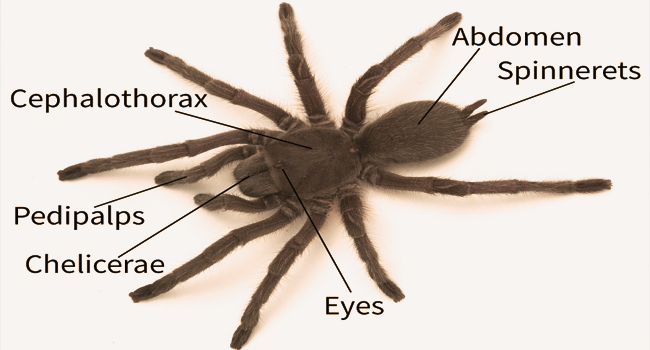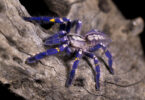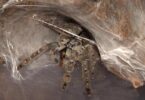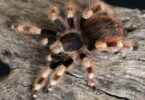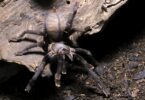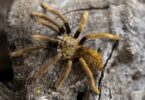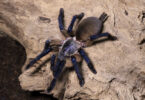Tarantulas are one of the most fascinating creatures in the world of arachnids. These giant, hairy spiders are known for their imposing presence and striking appearance. In this article, we will take a close look at the intricate anatomy of tarantulas, shedding light on their body structure and the unique features that make them stand out among arachnids.
The Exoskeleton
One of the most distinctive features of tarantulas is their exoskeleton. In contrast to humans, tarantulas have a hard outer shell that serves as both structural support and protection. This exoskeleton is essential for maintaining its shape and fending off potential threats.
The Prosoma and Opisthosoma
Tarantulas’ bodies consist of two main parts: the prosoma and the opisthosoma. The prosoma, also known as the cephalothorax, houses the tarantula’s vital organs, including the brain, heart, and digestive system. The opisthosoma, or abdomen, contains the respiratory organs, reproductive organs, and silk-producing glands.
Legs and Pedipalps
Tarantulas are renowned for their long, sturdy legs. These eight legs play a crucial role in their mobility, helping them move gracefully and hunt effectively. Additionally, tarantulas possess two specialized appendages called pedipalps, which aid in handling food and participating in mating rituals.
Spinnerets and Silk Production
Tarantulas are skilled silk spinners with spinnerets at the rear of their opisthosoma. They produce various types of silk, each serving a unique purpose. Some tarantulas build elaborate webs for trapping prey, while others use silk to create shelters or egg sacs.
Venomous Fangs
Tarantulas have venomous fangs that they use to immobilize their prey. The venom is a potent mix of enzymes and toxins that help break down the victim’s tissues, making it easier for the tarantula to consume its meal. The mechanics of their fangs are fascinating, allowing them to inject venom with precision.
Sensory Organs
Tarantulas have developed various sensory organs to navigate their surroundings effectively. While they are not known for their vision, they possess simple eyes that can detect changes in light and movement. Additionally, they have sensitive hair sensors, known as setae, on their bodies that help them perceive vibrations and touch.
Reproduction
Tarantula reproduction involves intricate courtship rituals. Males perform elaborate dances and drumming to woo females. After successful courtship, females lay eggs in silk egg sacs, which they guard until the spiderlings hatch.
Diet and Predatory Behavior
Tarantulas are carnivorous predators. They employ various techniques to capture their prey, including ambushing, stalking, and using silk to immobilize victims. Once the game is subdued, tarantulas use their strong jaws to consume it.
Defense Mechanisms
To protect themselves from potential threats, tarantulas have evolved defense mechanisms. They can flick urticating hairs from their abdomen, irritating the skin or eyes of predators. Tarantulas also display warning postures to deter potential threats.
Lifespan and Growth
Tarantulas grow by molting shedding their exoskeletons as they outgrow them. This process is vital for their development and allows them to increase in size. The lifespan of a tarantula can vary depending on the species and environmental conditions.
Different Tarantula Species
There are over 900 species of tarantulas, each with its unique characteristics. Some are known for their vibrant colors, while others are distinguished by size and behavior. Exploring the diversity of tarantulas is a thrilling endeavor for enthusiasts.
Importance of Tarantulas
Tarantulas play a vital role in their ecosystems as both predators and prey. They help control insect populations and contribute to the balance of their natural habitats. Additionally, they are kept as pets by many arachnid enthusiasts worldwide.
Conservation
Despite their importance, tarantulas face various threats, including habitat loss and the exotic pet trade. To preserve these amazing arachnids and their native environments, conservation initiatives are being carried out.
Fascinating Facts
- The Goliath birdeater tarantula is the most enormous spider by mass, with a leg span of up to 11 inches.
- The world’s smallest tarantula, the Pattytula, is just 0.28 inches long.
- Contrary to popular belief, most tarantulas are docile and pose little threat to humans.
Tarantulas: A World of Diversity
The world of tarantulas is a diverse one, with over 900 recognized species. Each species has unique characteristics, making them intriguing subjects for arachnid enthusiasts. Here are a few examples:
-
The Goliath Bird-Eater (Theraphosa blondi)
The Goliath bird-eater is a famous tarantula known for its massive size and impressive leg span. As the name suggests, this species is large and robust, with some individuals reaching up to 11 inches in leg span. While they primarily feed on insects, they can even consume small vertebrates when possible.
-
The Pink Toe Tarantula (Avicularia avicularia)
Contrary to the typical perception of tarantulas, the Pink Toe Tarantula is known for its striking pink coloration. These arboreal tarantulas are agile climbers and are often seen perched on trees. Their vibrant appearance and arboreal lifestyle make them a favorite among tarantula enthusiasts.
-
The Brazilian Salmon Pink Birdeater (Lasiodora parahybana)
The Brazilian Salmon Pink Birdeater is a terrestrial tarantula native to Brazil. These tarantulas are known for their impressive appetites and fast growth. They are one of the largest terrestrial tarantula species and can reach sizes of 10 inches in leg span.
-
The Cobalt Blue Tarantula (Haplopelma lividum)
This stunning tarantula species is known for its striking cobalt blue coloration. Native to Southeast Asia, the Cobalt Blue Tarantula is highly sought after by collectors. Their vivid color and reclusive nature make them an intriguing addition to the world of tarantulas.
Tarantulas as Pets
Many people around the world keep tarantulas as pets. Their docile nature, low maintenance requirements, and unique appearance make them popular choices among arachnid enthusiasts. However, keeping a tarantula as a pet comes with responsibilities.
It’s important to learn about the particular requirements of the species you choose to maintain before purchasing a tarantula. Factors such as enclosure size, humidity, temperature, and feeding requirements can vary among species. Ensuring that you create a suitable habitat is vital for the well-being of your pet tarantula. Additionally, always acquire your tarantula from reputable sources and avoid purchasing specimens captured from the wild. Captive-bred tarantulas are a more ethical and sustainable choice.
Tarantulas in Conservation
While tarantulas are fascinating creatures, some species face threats in the wild. Habitat destruction due to deforestation and the exotic pet trade are two significant concerns. To save these unusual arachnids and their native environments, conservation initiatives are being carried out. Supporting organizations dedicated to the conservation of tarantulas and their ecosystems can make a positive impact. These efforts can help ensure the long-term survival of these remarkable creatures.
Conclusion
In conclusion, the world of tarantulas is a captivating one, filled with incredible adaptations, behaviors, and diverse species. Their unique anatomy and role in ecosystems make them a subject of fascination for both arachnid enthusiasts and scientists alike. The intricate details of tarantula structure and behavior continue to reveal the beauty of the natural world.
FAQs
1.Are tarantulas dangerous to humans?
While some tarantulas have venomous bites, they are generally not lethal to humans. Most species are docile and rarely bite.
2.Can tarantulas be kept as pets?
Yes, many tarantula enthusiasts keep them as pets. It is imperative that you investigate the particular requirements of the species you plan to house.
3.What do tarantulas eat?
Tarantulas are carnivorous and primarily eat insects, but larger species may consume small vertebrates.
4.How long do tarantulas live?
The lifespan of a tarantula varies by species.

